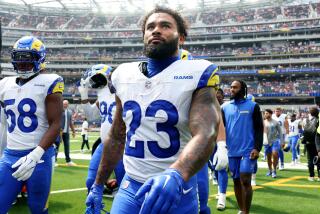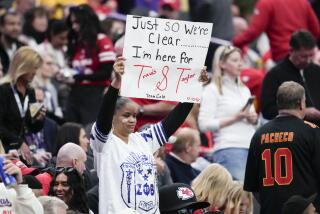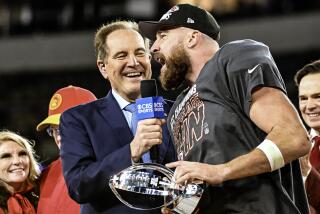Column: Green Bay’s memories of 1967’s Ice Bowl with Dallas are frozen in time
By midweek, there will be 2.8 million people in Wisconsin, or roughly half the population of the state, claiming to have been at the Ice Bowl.
It will be the hot topic of conversation at banks, bakeries and any place they sell bratwurst, which is about every restaurant.
You might as well have Paul Revere riding down Wisconsin Avenue in Milwaukee, proclaiming: “The Cowboys are coming! The Cowboys are coming!”
The very thought of Dallas at Green Bay on Sunday to play the Packers in an NFL playoff game — for the first time since New Year’s Eve 1967 — stirs memories in Wisconsin sports fans like nothing else. It is the kind of thing that warms the cockles of their hearts, except in Wisconsin, it does more than that. It melts the cheese on their heads.
What a time it was back then. What incredibly wonderful memories!
It was the NFL championship game. The Packers had already won the previous two, as well as the first of some new-fangled promotional event created by Pete Rozelle. The NFL called it the Super Bowl and the winner of this game would play in Super Bowl II.
But the NFL title was the big deal. The week before, the Packers beat the Rams, the Cowboys beat the Browns and it was Game On for Dec. 31, 1967.
The day before, temperatures were in the mid-teens and the more hardy Packers fans were deciding on which Packers color, gold or green, to paint their naked chests.
Then a cold front blew in, much earlier than the forecasters predicted. It would be the coldest-ever New Year’s Eve in Green Bay, and a legend was born.
As the sun rose, the temperature was 15-below zero. The wind blew, and for awhile, the windchill factor approached 50-below.
Several Packers players couldn’t get their cars started in the cold and didn’t worry. They were certain they wouldn’t play a game in this weather.
Cowboys players, awakened in hotel rooms by operators telling them it was 15-below, thought it was a joke, a local scheme to psyche them out.
Sam Blair of the Dallas Morning News wrote years later of the Cowboys’ George Andrie, going out early and returning to roommate Bob Lilly. He told Lilly it was cold beyond belief. Lilly scoffed. Andrie had played at Marquette. He knew Wisconsin winters. He filled a cup with water, walked to the window of the 70-degree room, pulled back the curtain and tossed water halfway up the window. It froze before it got to the window ledge.
At game time, it was 13-below and minus-48 windchill.
Vince Lombardi, Packers legend and coach, had no trouble starting his car. Like many in Wisconsin, his garage was heated. But when he got to Lambeau Field, he was told the electric coil system he had had installed to keep the turf warm, at a cost of $80,000, had failed.
They shoveled off the field, which had the traction of a skating rink. The sidelines were snow and ice.
Among broadcasters doing the game were Ray Scott and Frank Gifford.
Scott was known for his sparse use of words. Today, announcers babble interminably. Scott described the action in semicolons: “Starr; Dowler; Touchdown.” Gifford cleverly captured the essence of the day when he told the audience: “I think I’ll have a bite of coffee.”
A capacity crowd of 50,861 showed up. One died of exposure.
This fan loyalty was not insanity. It was Wisconsin, at a time when the Packers were all they had. The beloved Braves had been carpet-bagged off to Atlanta in 1966 and the expansion Bucks didn’t start playing until 1968.
Most fans supplemented their blood supply with alcohol. Some brought sleeping bags, crawled in, sat up, zipped up and left a little hole to watch. Others, such as sportswriter Mike Juley of the Milwaukee Journal, admitted his apparel for the game included “hush puppies and one pair of socks.”
Rugged people, those Wisconsin sports typists.
A marching band performed pregame, and only a half-dozen tuba players had to bloody themselves, tearing lips from horn. Referee Norm Schachter got his whistle stuck to his lip and soldiered on with frozen blood on his face. Whistles were useless, so officials worked the game with hand signals and by yelling.
Lombardi stuck to his rule about cold-weather games. Only linemen could wear gloves. The Packers noted, and keyed on, Dallas wide receiver Bob Hayes, who seemed to keep his hands in his pants on all plays that weren’t passes.
The Cowboys were tough, the Packers tougher.
Green Bay linebacker Ray Nitschke had frostbite on most of his toes, but didn’t notice until hours later, at a celebration party.
The toughest was Bart Starr, the mild-manner, gentlemanly quarterback, who got the ball with his team trailing, 17-14, and 4:50 to play. During that final drive, according to some reports, there were moments when the wind-chill was 70-below.
Starr kept looking downfield. As soon as Cowboys’ defensive backs skated backward, he tossed swing passes.
With 16 seconds left, third-and-goal on the Dallas one, Starr called a final timeout and jogged to the sideline for the now-famous conversation with Lombardi. The obvious call was a short pass, because if it fell incomplete, the clock would stop, with time for one more play.
Instead, Starr told Lombardi his backs and receivers were sliding around and his right guard, Jerry Kramer, could get enough leverage for a straight-ahead run they called “Wedge 31.” Except, Starr had no intention of handing the ball off. He was going to keep it and slide right behind Kramer.
It remains unclear whether Lombardi approved, or, at that stage, was frozen beyond any tactical ability. He told Starr, “Let’s do it and get the hell out of here.”
That they did. Starr squeezed into the end zone behind Kramer and center Ken Bowman. The glut of pictures of that moment vaulted Kramer to fame in a best-selling book, “Instant Replay.”
Two weeks later, the Packers won Super Bowl II, beating Oakland in Miami. The temperature was about 80 degrees higher.
This Sunday in Green Bay, it is expected to be in the mid-teens. That’s paint-the-naked-chest weather.
Two days prior, Bart Starr will turn 81. He is recovering from a stroke he had in September. Chances are, if he is able and there is a TV nearby, he’ll be watching.
If he does, it is likely that, with the memories, chills will run through his body. And not just from the excitement of the game.
Twitter: @DwyreLATimes
More to Read
Go beyond the scoreboard
Get the latest on L.A.'s teams in the daily Sports Report newsletter.
You may occasionally receive promotional content from the Los Angeles Times.











